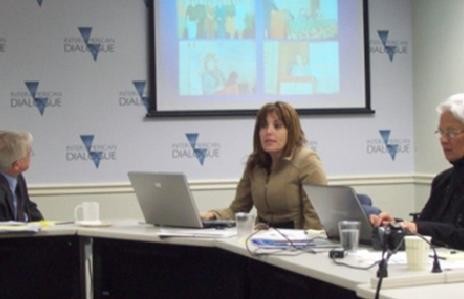China, India & Colombia’s Interbolsa
Colombian firm Interbolsa is being liquidated in a move to protect the interests of Colombia’s financial markets.
Tomorrow, April 22, on the 51st Earth Day, US President Joe Biden will kick off what promises to be a signature campaign of his presidency: a mission to rally nations around the world to unprecedented climate action. At a virtual Leaders Summit on Climate, Biden will mark the return of the United States to the Paris Agreement with what is expected to be a bold new Nationally Determined Contribution. He will appeal to other countries to raise their ambitions as well, and push for greater support for vulnerable countries to adapt to the mounting impacts of climate change.
Just as Biden tackles one of his greatest foreign policy challenges, his administration is also grappling with one of its most vexing and urgent domestic issues: an immigration system gravely overextended by an increase in migrants at the southern border. More than 170,000 migrants arrived in March, the highest number since 2006. They have largely originated in the Central American region often referred to as the Northern Triangle (El Salvador, Guatemala, and Honduras), fleeing a complex mix of gang violence, poverty, inequality, corruption, weak rule of law, and other factors. Covid-19 has amplified the effects of some of these problems. And though they are by no means the leading drivers of migration, disasters, hunger, and economic insecurity fueled by the impacts of climate change (to which Central America is particularly vulnerable) are increasingly important and expected to accelerate.
Thus, making climate change a central theme of a renewed US focus on the root causes of migration from the Northern Triangle presents an opportunity for the Biden administration to address its border dilemma while simultaneously advancing its climate-related foreign policy goals.
Climate change contributes to Central American migration in many ways, and largely through its intersection with other structural factors that push people to leave. The easiest to visualize is the devastation wrought by extreme weather events such as 2020’s Hurricanes Eta and Iota. Scientists have linked warming oceans to stronger storms and described the striking of these Category 4 storms just two weeks apart as unprecedented. Their impacts were harrowing. According to USAID, they affected nearly 9 million people in Guatemala, Honduras, and Nicaragua, displacing hundreds of thousands from their homes and exacerbating preexisting humanitarian and economic crises. At least 230 people perished. In Honduras, where nearly half the population was affected, the World Bank preliminarily estimated economic losses of $2.8 billion (GDP was $25.1 billion in 2019) and damage to 85,000 homes. The destruction of 800,000 acres of crops and the disruption of the sowing cycle have raised the specter of famine this year.
In addition to increasingly calamitous individual weather events, Central Americans are also threatened by a more pernicious general growth in both flooding and drought in the agriculture-dependent Dry Corridor, the majority of which is located in the Northern Triangle and Nicaragua. Agriculture employs a large share of the workforces of these countries—more than 30 percent in Guatemala and Honduras. According to the Migration Policy Institute, floods and droughts, often hard to forecast and linked to the increasingly frequent and intense El Niño phenomenon, combine with factors such as poverty, low access to health care and financial services, damage to rural infrastructure by disasters, deforestation, and lower fish stocks during El Niño years to produce extreme rural food insecurity. The UN’s World Food Program (WFP) USA states that of 2.2 million people currently affected in the Dry Corridor, 82 percent are resorting to “crisis-level coping strategies, including selling agricultural tools and animals, skipping meals, and eating less nutritious food.” A 2019 survey by the UN Food and Agriculture Organization and WFP found that 8 percent of families in the region intended to migrate due to the conditions.
Most of these migrants are not initially bound for the United States. Instead, they head to nearby towns or to cities, which “quickly grow overcrowded…stretch[ing] infrastructure, resources, and services to their limits,” according to a 2020 New York Times/ProPublica report. Urban migrants from rural areas often become concentrated in “slumlike suburbs” of cities like San Salvador, where public services, good jobs, and the state are practically absent and gang violence proliferates. In a process known as “stepwise migration,” migrants gradually take greater risks and move farther from home in pursuit of opportunity. Some eventually arrive at the southern border of the United States. The report’s model suggests that if governments take only “modest action” to reduce emissions, 680,000 migrants driven primarily by climate (5% of migrants are projected to fall in this category) will reach the US from Central America and Mexico between now and 2050. Unchecked, climate change could produce over a million such migrants—excluding undocumented immigrants, who could number twice as many.
As the consequences of climate change build in Central America and elsewhere, Biden is carving out a central role for climate change in his presidency. One week after taking office, he signed a sweeping executive order that, among many other measures, mandated the infusion of climate change into all aspects of US foreign policy. Biden wants the United States to reach net-zero emissions by 2050 and to urge other countries to step up as well. At this week’s summit, the White House aims to keep the more ambitious of the Paris Agreement’s targets (an increase of less than 1.5 degrees Celsius above pre-industrial levels) within reach and drum up financial support for at-risk countries to adapt to climate impacts. Of the 40 countries invited to the summit, 17 account for roughly 80 percent of global emissions. Vulnerable countries, including Antigua and Barbuda, a Caribbean nation whose smaller island (Barbuda) was decimated by Hurricane Irma in 2017, are also represented, though no Central American countries are included.
Despite their low greenhouse gas emissions per capita relative to countries like the United States, Northern Triangle countries are taking steps to do their part. Guatemala aims for a reduction of 11.2 percent (22.6 percent with international support) of its total greenhouse gas emissions by 2030 (relative to a business-as-usual (BAU) scenario with 2005 as a base year). El Salvador has a goal of reducing its energy sector emissions by 46 percent relative to BAU by 2025. And Honduras hopes to reduce its emissions by 15 percent (relative to BAU and conditioned on international support) and reforest 1 million hectares of forest coverage by 2030.
Aid from the Biden administration can support progress toward these goals while enhancing opportunity and prosperity for would-be migrants and stemming migration’s root causes. Three key officials that Biden has appointed to respond to the strain on America’s immigration system—Vice President Kamala Harris, Coordinator for the Southern Border Roberta Jacobson (who is stepping down at the end of April), and Special Envoy for the Northern Triangle Ricardo Zúñiga—have already been involved in climate-related conversations, largely focused on adaptation and resilience.
On April 9, the White House requested $861 million from Congress for the Northern Triangle as part of Biden’s first budget proposal. Using some of these funds to advance climate change mitigation and adaptation efforts could directly contribute to development and alleviate both climate-related and non-climate drivers of migration. Notably, the $4 billion four-year Northern Triangle aid package mooted by the Biden campaign contemplates grid modernization, a transition to clean energy, and doubling the capacity of the Central American Electrical Interconnection System (SIEPAC by its Spanish initials) in addition to adaptation and resilience measures. Some of these objectives carry over from Biden’s leading role in Central America energy assistance as vice president.
Investment in renewable energy is one area with potential to yield benefits beyond climate change mitigation. Paired with investment in technical education and training, it could create higher-value jobs and reduce dependence on agriculture and manufacturing. Increasing the supply of affordable and reliable energy could also catalyze economic development. Electricity in Central America is expensive—in September 2020, six of the seven Latin American countries with the highest business electricity prices were in Central America, according to one database. In 2019, two thirds of the Northern Triangle’s electricity was generated by fossil fuels, which are largely imported and have volatile prices, or hydropower, which is threatened by droughts. Parts of Guatemala (> 5 percent of the population) and Honduras (> 8 percent) remained without electricity at all as of 2018.
Moreover, parts of the Northern Triangle are rich in renewable energy potential, particularly solar and geothermal. Auctions for renewable energy across Latin America, including in El Salvador, have yielded competitive prices. Diversifying generation sources will reduce vulnerability to oil price spikes and droughts, and decentralization of generation and implementation of energy storage could increase resilience to disasters. The creation of solar microgrids with battery storage could bring electrification to the region’s remaining non-electrified rural areas without expensive transmission investments. Greater clean energy usage could also improve health in Central American cities. Guatemala and El Salvador are two of the top four countries in Latin America with the highest proportion of deaths associated with air pollution from burning fossil fuels (9.2 percent and 9.1 percent, respectively).
Despite the possibility of renewable energy jobs in the future, dependence on agriculture is likely to continue in the near term due to the current skills and education of the labor force. This means adaptation will be paramount in rural areas. Nature-based solutions such as reforestation could create alternative sources of income and food to agriculture, making rural families less vulnerable to the destruction of their prospects by a weak harvest or a hurricane. Reforestation could also reduce net emissions and mitigate climate impacts like erosion and flooding. The region’s forests have been razed by illegal cattle ranching, oil palm plantations, and cocaine trafficking—three of Central America’s largest forests were reduced in size by more than 23 percent from 2002 to 2017. Bolstering forest protections and rooting out the illicit activities driving deforestation would make communities safer. And financially empowering indigenous groups to be forest stewards and strengthening indigenous land rights, which studies have shown to be a highly effective conservation strategy, would resonate with the values of indigenous communities. Proactive engagement with local communities and existing civil society infrastructure is essential to the success of these measures.
Finally, the Northern Triangle’s weak institutional capacity and rule of law have long been leading drivers of migration, and their strengthening would bring clear benefits for mitigating and adapting to climate change. Transparency is needed for the proliferation of high-value contracts necessary to expand renewable energy. City planning must involve broadening access to housing outside of disaster-prone areas while limiting housing within them. Emergency response capabilities need to be scaled up. As discussed, the rule of law must be established in the region’s forests. A more educated workforce, particularly in the skills that clean industries demand, would help diversify the economy.
These problems are nothing new and anything but simple, but the reengagement of the United States with the Northern Triangle to address them is an important step. Biden’s high-level envoys to the region suggest he understands the gravity of the situation, and this week’s Earth Day summit is a chance to further demonstrate the same on climate. The question is whether he and his team will capitalize on the chance to respond to both climate change and migration in Central America in one fell swoop.
Biden’s Central America Plan: Perspectives from the Region (Event summary)
Central American Migration: Current Changes and Development Implications (Report)
Let’s Work With Latin America to Fight Climate Change (Op-ed)
Colombian firm Interbolsa is being liquidated in a move to protect the interests of Colombia’s financial markets.
Workshop that seeks to promote debate on teacher policy and showcase innovative policies.
PREAL reviews broad spectrum of its activities and discusses priorities for improving education policy in the coming year.

